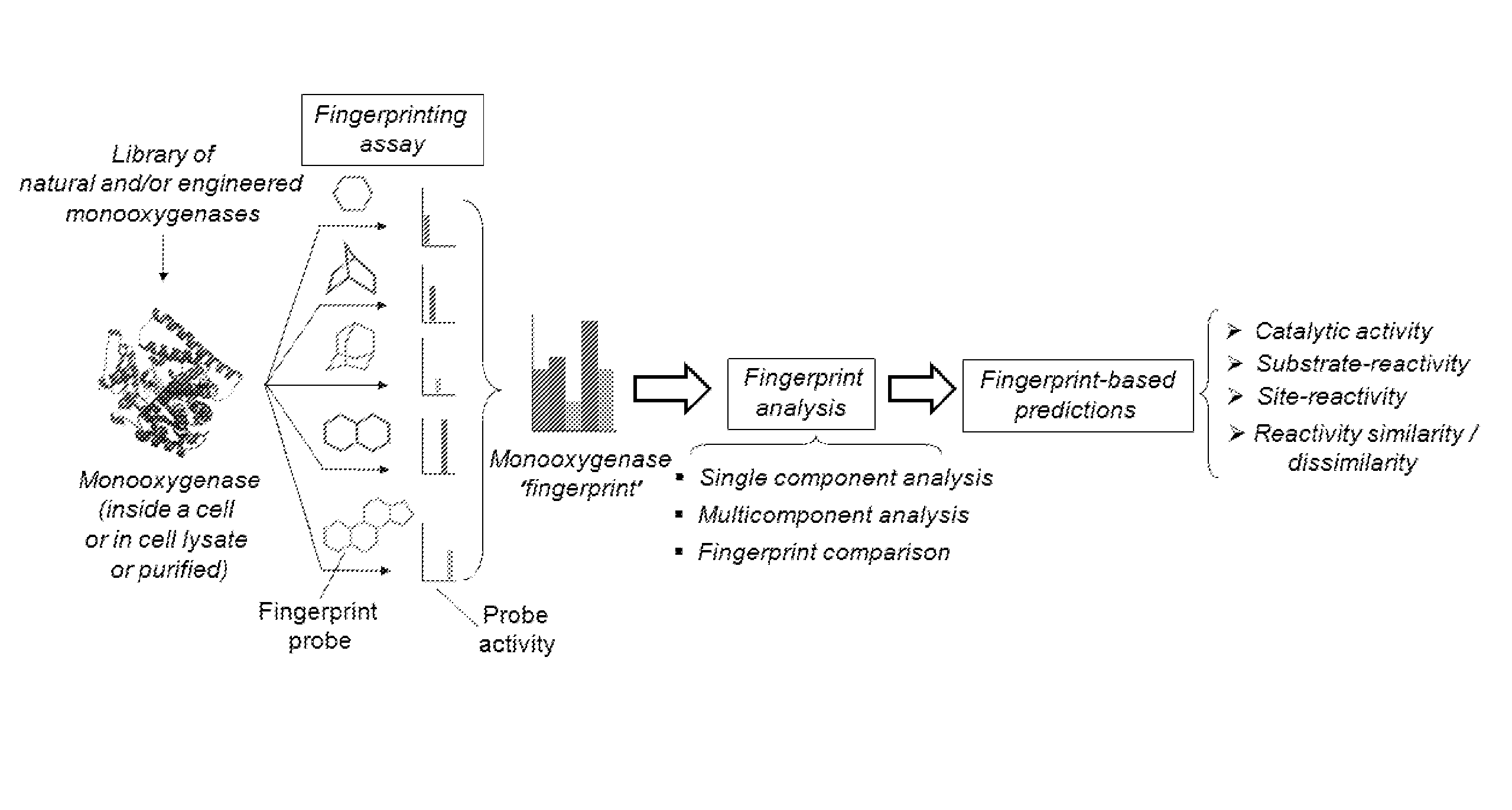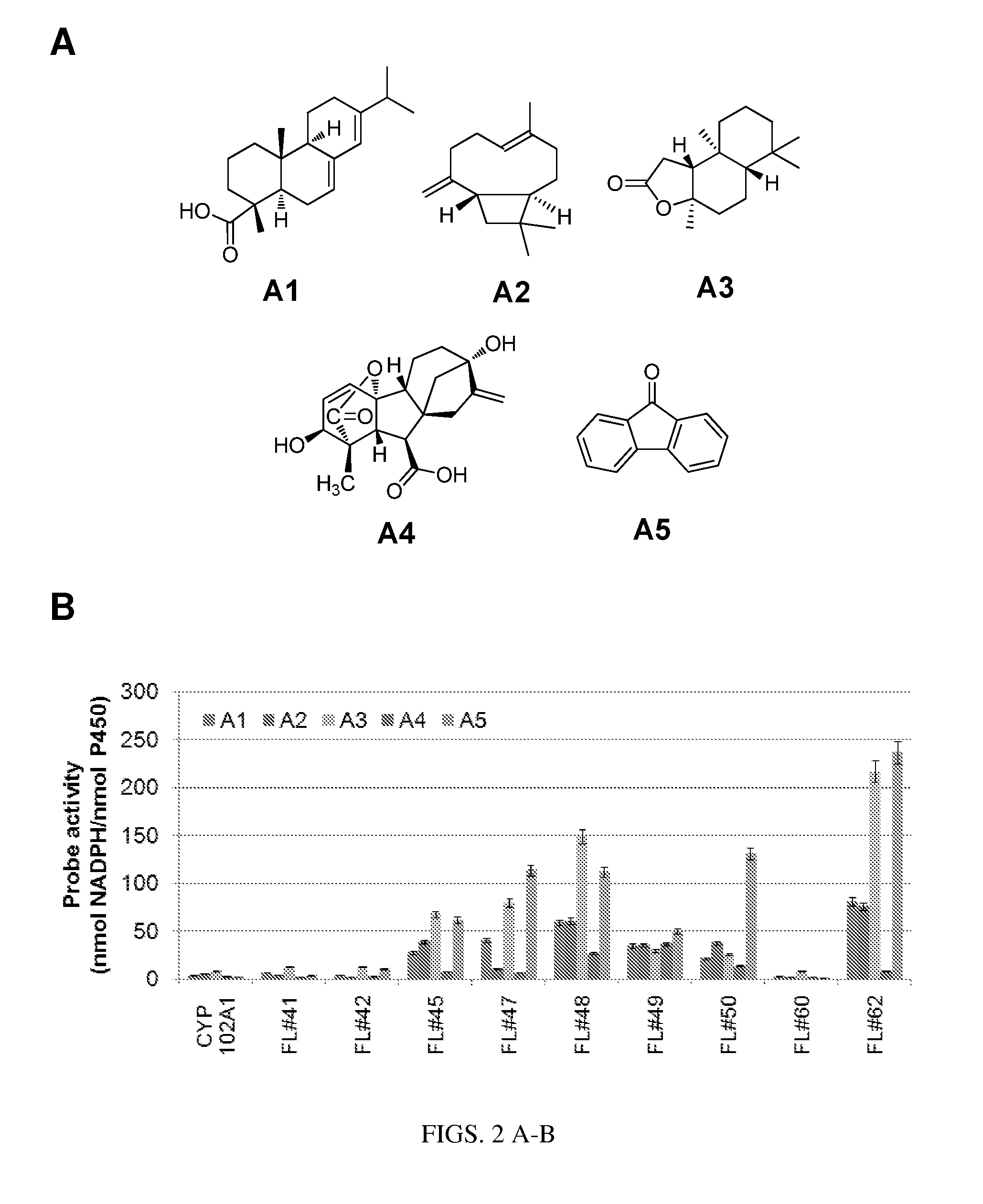Methods and systems for evaluating and predicting the reactivity of monooxygenase enzymes
- Summary
- Abstract
- Description
- Claims
- Application Information
AI Technical Summary
Benefits of technology
Problems solved by technology
Method used
Image
Examples
example 1
6.1 Example 1
Fingerprinting of a Monooxygenase Library Using Different Probes Sets
[0217]This example illustrates how functional fingerprints for a library of P450 monooxygenases can be acquired according to the methods provided herein. In particular, this example illustrates how a library of P450 monooxygenase variants can be fingerprinted using a set of fingerprint probes of general formula I. In this case, a first set of fingerprint probes (FP probe set 1) was assembled which include the organic molecules of FIG. 2A. A second set of fingerprint probes (FP probe set 2) was also assembled which include the organic molecules of FIG. 3A. In both cases, a collection of P450 monooxygenases including wild-type CYP102A1 (SEQ ID NO:1) and various engineered CYP102A1 variants (SEQ ID NO:3, SEQ ID NO:4, SEQ ID NO:6, SEQ ID NO:8, SEQ ID NO:9, SEQ ID NO:10, SEQ ID NO:11, SEQ ID NO:14, SEQ ID NO:15) in purified form was used as the monooxygenase library. In this example, probe activity was meas...
example 2
6.2 Example 2
Design, Synthesis, and Application of Methoxy-Containing Probes for Monooxygenase Fingerprinting
[0222]This example illustrates how probes containing a reporter functional group in the form of a methoxy group can be prepared and utilized to acquire a functional fingerprint for a collection of P450 monooxygenases according to the methods provided herein. In particular, five methoxy-containing fingerprint probes of general formula II were synthesized starting from 4-pentyl-cyclohexanol, (−)-borneol, 2-adamantanol, nootkatone, and progesterone (compounds I-5, FIG. 4A). (−)-Borneol, nootkatone, and progesterone are members of the terpene family of natural products, which further illustrates how naturally occurring compounds can also be utilized to generate methoxy-containing probes for use in the methods provided herein, in addition to synthetic molecules (e.g., 2-adamantanol).
[0223]This probe set was designed to contain a series of molecular scaffolds with marked difference...
example 3
6.3 Example 3
Identification of Substrate-Reactive Monooxygenases Via Probe-Target Molecule Molecular Similarity and Fingerprint Analysis
[0233]This example illustrates the application of one embodiment of the method for enabling the rapid identification, within a library of fingerprinted monooxygenases, of those members that are catalytically active on a series of relevant target substrates. Specifically, this embodiment of the method involves the assessment of the molecular similarity between the target compound and the fingerprint probes followed by substrate-reactivity predictions via fingerprint analysis.
[0234]The 261 unique-fingerprint monooxygenase variants isolated in Example 2 were pooled to form a collection of fingerprinted P450 monooxygenases. Six different molecules, pentylcyclohexanol (6), menthol (7), bomeol (8), camphorsultam (9), 11,12-dihydronootkatone (10), and sclareolide (11), were selected as target molecules. These are representatives of compounds of commercial ...
PUM
 Login to view more
Login to view more Abstract
Description
Claims
Application Information
 Login to view more
Login to view more - R&D Engineer
- R&D Manager
- IP Professional
- Industry Leading Data Capabilities
- Powerful AI technology
- Patent DNA Extraction
Browse by: Latest US Patents, China's latest patents, Technical Efficacy Thesaurus, Application Domain, Technology Topic.
© 2024 PatSnap. All rights reserved.Legal|Privacy policy|Modern Slavery Act Transparency Statement|Sitemap



